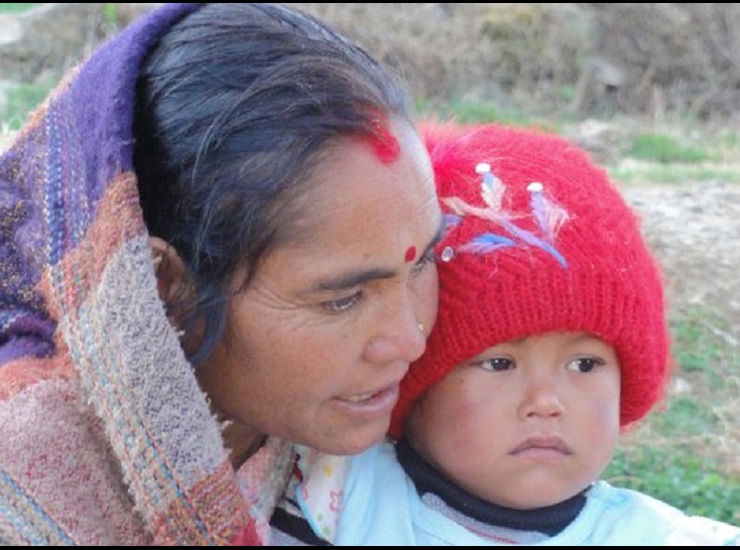
Over the years, I have spent stints of time in remote parts of the world, studying how children learn language. Watching the ways in which babies and young children were looked after and learned to talk in these cultures has made me think about what we know about children’s development in cultures very different from our own and how this might be influenced by the ways in which they are raised1.
In the 1970s, I lived for 6 months in a very remote village in Papua New Guinea. Children spent all their time with their mothers, carried in slings up to the age of about 2 and after that perched on top of great piles of wood and food carried by the mothers as they walked long distances to their gardens and back. As the mothers walked to and from the gardens they would give a running commentary to their children about who was in what garden and what they were doing. I thought this could have helped the babies learn the correct kinship names for people (a very important part of what you needed to know when you either talked to people or talked about them), as well as the words for many types of food, activities and the layout of the terrain.
This made me think about the different ways in which toddlers learn words. From research in our own cultures, we know that joint attention to objects and events is important for word learning, but maybe there are other ways to learn by attending to what the mother is talking about without the immediate ‘jointness’ of attending to objects together while you talk about them. A study of rural Mozambican babies showed that they spent more time in solitary engagement with objects than urban children and that it was joint engagement with people that predicted their vocabulary growth2.
How much of the talk babies hear matters for learning to talk?
During the first year of life babies become increasingly sensitive to the sounds, words and structure of the language or languages that they hear around them. We don’t really know how much language they need to hear for this process to proceed normally, but we do know that there are big differences in how much babies are talked to, not only between caregivers in our own cultures but also across cultures. For instance, in some cultures people think that babies shouldn’t be over-excited by too vigorous interaction, in others they don’t see the point of talking to babies until they can talk. And yet children the world over do learn to talk. So we need to know much more about the different ways in which they are spoken to and by whom.
My colleague, Sabine Stoll, and I conducted research in Eastern Nepal on an endangered language called ‘Chintang’. Here, young babies were also carried in slings by their mothers but once they started to crawl and walk, they spent much more time with other children, often being carried around on the older children’s backs until they were old enough to run around with them. Children spent most of their time outside surrounded by other children and other adults and so they heard a much greater variety of speakers from an early age. These children interacted all the time with a much wider range of speakers than the children we usually study here in the UK.
I am currently working with Sabine on a study of the speech addressed directly to children and that around them, looking at what the children pick up from different speakers and how important directly addressed speech seems to be. It’s interesting that a big study of early social communicative skills in villages in India, Peru and Newfoundland found that mothers reported the same age at which children started to comprehend words (9 months) but the Canadian children were reported to be 3 months ahead in producing words3. So, maybe high levels of child directed speech produce more talkative children.
What’s the same and what’s different about early development and communication in different cultures?
On the one hand, babies the world over are obviously on a developmental timetable, smiling around 6 weeks, reaching out for objects around 4-6 months, walking and starting to talk at around 1 year, although there are individual differences in exactly when they reach these milestones. Not only this, they seem to be on a similar timetable for social communication: a number of studies including one that Sabine and I have published, on the Chintang children, have shown that children across very different cultures start to understand words, show and give objects, point and imitate, at similar ages4.
Does interaction and communication with babies matter?
Obviously it does, no child is going to develop normally or learn a language in the absence of any human interaction or hearing a language! Early on this takes place in the contexts of meeting a baby’s basic needs for food, care and sleep. After all, there are limited options for dealing with very young babies and we may, to some extent, be programmed to provide them (think about the almost biological response people have to newborn crying). This may ensure that very early development proceeds smoothly unless there are major disabilities or early traumas to mother or child.
But we know from studies in our own cultures that there is a relationship between both the quantity and quality of interaction with toddlers and their language development. There is evidence for relations between the amount mothers talk to their 18-month-old toddlers and the speed with which the toddlers process speech5; between the amount of joint attention that mothers and babies engage in and children’s vocabulary development; and between the amount that caregivers talk to babies and the rate at which they learn words and the size of their early vocabularies.
Later on, contingent talk (where caregivers talk about what the toddler is attending to) is related to the range and complexity of their child’s language. And, of course, there is good evidence that children’s oral language skills are related to their school readiness and later reading development. But we still have a long way to go in understanding the details of exactly how these relationships work and the intricate ways development and interaction at one time point have an influence on later development. (For an absolutely marvellous account of the ways in which the use of language varied between different communities in the USA and how this worked its way out in the context of early schooling and literacy, I recommend Ways with Words by Shirley Brice Heath6).
What can we take from all of this?
Children learn to talk in a wide range of different environments all over the world. From studies in our own society, we know something about what helps and hinders this process. But there is so much more to learn. Thinking about these cultural differences really makes me think more deeply about the process of language development in our own society:
(1) What about different groups in our own society? - Do children all learn to talk in exactly the same way? How much language do they need to hear and from whom?
(2) How exactly do early differences between children and between their environments work their way out to produce the differences in school readiness and outcomes that we know exist?
More questions than answers! But lots of our research in LuCiD is aimed at investigating these questions. Find out more on our research pages.
This article was written for the National Literacy Trust. Elena is the Keynote Speaker at their Talk to Your Baby conference, taking place on 13 March 2017. The original article can be accessed here.
References
1. Lieven, Elena (2013) Language acquisition as a cultural process. In Peter J. Richerson & Morten H. Christiansen (eds.). Cultural Evolution: Society, Technology, Language, and Religion. Strüngmann Forum Reports, vol. 12, J. Lupp, series editor. Cambridge, MA: MIT Press. ISBN 978-0-262-01975-0.
2. Mastin, J. D., & Vogt, P. (2016). Infant engagement and early vocabulary development: a naturalistic observation study of Mozambican infants from 1; 1 to 2; 1. Journal of child language, 43(02), 235-264.
3. Callaghan, T., Moll, H, Rakoczy, H., Warneken, F., Liszkowski, U., Behne, T., Tomasello M. (2011). Early social cognition in three cultural contexts. Wiley-Blackwell.
4. Lieven, E., & Stoll, S. (2013). Early communicative development in two cultures: A comparison of the communicative environments of children from two cultures. Human Development, 56(3), 178-206.
5. Hurtado, N., Marchman, V. A., & Fernald, A. (2008). Does input influence uptake? Links between maternal talk, processing speed and vocabulary size in Spanish‐learning children. Developmental Science, 11(6), F31-F39.
6. Heath, S. B. (1983). Ways with words: Language, life and work in communities and classrooms. Cambridge. Cambridge University Press.

